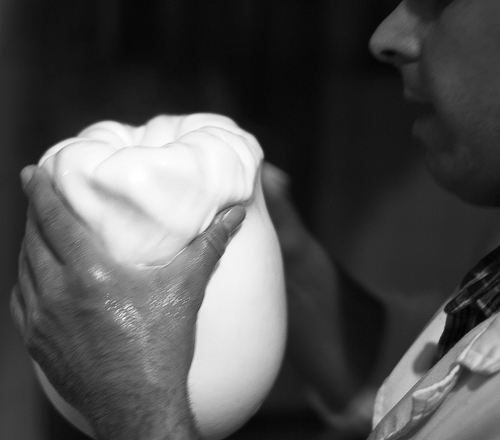We went to the house of Gianpaolo and Barbara Mura in the evening after having ascended a long series of steps in the historic centre of Santu Lussurgiu. Gianpaolo met us at the entrance of their fine house and led us up their neat dairy from whose ceiling were hanging the traditional “Su Casizolu“, that is typical, Sardinian cow’s cheese, produced in the region of Montiferru.
Gianpaolo e Barbara, being in their twenties, are running a farm having been started more than 200 years ago in accordance with nature’s cycles. They are raising cows of a race called Sardo-Modicana living outside all year in pastures being supplemented with organic fodder from fields between the hills of Montiferru and the valleys approaching Oristano.
The extension of their property amounts to several hundred hectares, but being divided into three different parts situated in three communes. The herd moves from the highlands to the lowlands in winter and vice versa in summer. The Sardo-Modicana race derive from cross-breeding the Modicana race imported from Sicily in the early 1800s with local races in the Montiferru region and being meant for working. Quite early on, it was discovered that the cheese obtained from the milk of the Sardo-Modicana cows was excellent and getting the name Casizolu. Besides, the meat of the Sardo-Modicana cattle has also been discovered to be of prime quality. Now, veal of the highest quality called “Bue Rosso” or “Red Bull” is obtained from the Sardo-Modicana calves.
Gianpaolo and Barbara, although producing “Bue Rosso”, are more interested in talking about their rare cheese shaped like a giant pear. In fact, they are proud of their production of cheese firmly anchored to the cycles of the seasons and the reproductive cycles of their animals, but they won’t have their product nominated as a Slow Food presidium because they want to be independent.
In order to make the “Su Casizolu” cheese, the curd has to be kneaded manually until it becomes smooth and thready, while at the same time keeping it at a temperature of 45°C. At our arrival, Barbara was busy kneading the curd, a work which seemed quite laborious and long-lasting. After she had finished her work, Gianpaolo cut off a part of the curd and started forming a baseball-sized ellipsoid. Then, he started reshaping it such that the lower part is round and large, while the upper part is slender, ending in a fine, wide rosette.
After having shaped the cheese to his liking, he put it into a container of water filled with salt, rotating it regularly such that the shape remained symmetrical. The cheeses had to stay in the water until the temperature had decreased to 20°C. Then, he would put the cheese in a net and hang it up on a beam located close to the ceiling for drying.
Before leaving, we were shown the cheese cellar of Barbara and Gianpaolo, that is a a room without windows with a temperature ideally suited to let the cheeses justly dried, mature. In fact, the ceiling was more or less covered with maturing cheeses.

